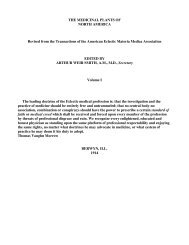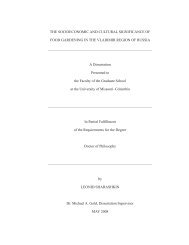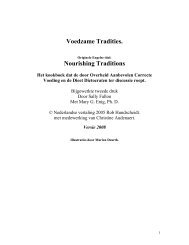FACTORS OF SOIL FORMATION - Midlands State University
FACTORS OF SOIL FORMATION - Midlands State University
FACTORS OF SOIL FORMATION - Midlands State University
You also want an ePaper? Increase the reach of your titles
YUMPU automatically turns print PDFs into web optimized ePapers that Google loves.
compare pieces with equal surface areas. Since we know of no<br />
reliable method to determine surface area of alumino-silicates, the<br />
weathering series mentioned above can have no claim to finality.<br />
In nature, the extent of chemical rock decay may be very<br />
deceiving. Niggli's (20) decomposed gneiss of San Vittore-Lumino,<br />
Misox (T = 10.9°C, N S quotient = 624) has all the appearances of a<br />
completely weathered rock; yet chemical analysis can detect little<br />
change other than hydration and oxidation.<br />
Significance and Behavior of Cations.—The nature of the<br />
elements released during rock decay has a specific bearing on soil<br />
formation. Silicon and aluminum furnish the skeleton for the<br />
production of clay colloids; iron and manganese are important for<br />
oxidation-reduction processes, and they strongly influence soil color;<br />
potassium and sodium are dispersing agents for clay and humus<br />
colloids, whereas calcium and magnesium have high flocculating<br />
powers and assure soil stability.<br />
Acid igneous rocks contain considerable amounts of quartz and<br />
are rich in monovalent cations, whereas basic igneous rocks are high<br />
in calcium and magnesium contents. One would expect that these<br />
chemical and mineralogical differences would be reflected in the<br />
trend of soil formation. Indeed, Hart, Hendrick, and Newlands (9) in<br />
their studies on the soils of Scotland found that, under conditions of<br />
identical climate and topography, the basic igneous rocks produce<br />
brown earth and the acid igneous rocks produce podsolized soils.<br />
It is a common saying that acid igneous rocks give rise to soils of<br />
good physical condition, whereas soils from basic rocks possess<br />
favorable chemical characteristics that ensure abundant plant growth.<br />
Aside from the fact that well-known exceptions exist (e.g., serpentine<br />
soils), it is probable that such belief originated in regions where<br />
chemical weathering is not pronounced. In warmer climates with<br />
extensive leaching and removal of bases, the chemical influence of<br />
the parent rock is likely to be less marked. Cobb's work seems to<br />
support this conclusion.<br />
Cobb (4) has published chemical analyses of igneous rocks and<br />
soils derived therefrom that were collected in the North Carolina<br />
section of the Piedmont Plateau. He arranged the data in the form of<br />
two development series as follows:<br />
Cobb's analyses, recalculated to molecular values, are<br />
plotted in Figs. 31 and 32.<br />
The ba values, or the base-alumina ratio that reflects the<br />
leaching of potassium, sodium, and calcium, and the relative
















